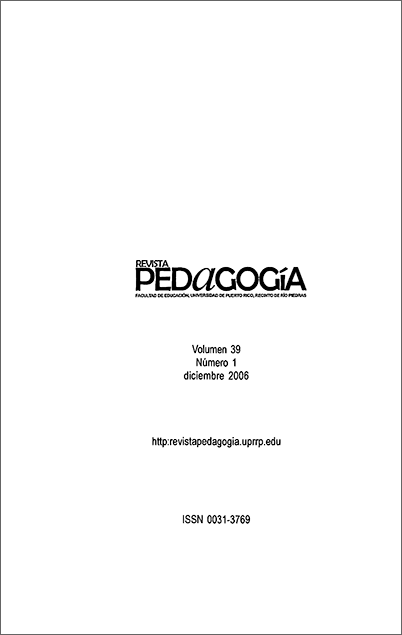Resumen
Cómo citar:
Nazario, G. M. & Burrowes, P. A. (2006). Pruebas para evaluar el entendimiento conceptual en cursos de zoología y botánica. Pedagogía, 39(1), 150-170.
Citas
Burrowes, P. A. (2003). A Student-Centered Approach to Teaching General Biology That Really Works: Lord's Constructivist Model Put to a Test. The American Biology Teacher, 65(7): 491-502.
Campbell, N. A. & Reece. (2002). Biology(6ta. ed). New York: .Benjamin/Cummings.
Fredette, N. & J. Lockhead. (1980). Students Conceptions of Electric Current. The Physics Teacher, 18: 194-198.
Halpem, D. F. (1997). The war of the worlds: when students conceptual understanding clashes with their professors. The Chronicle of Higher Education (1997): B5.
Hickman, C. P., L. S. Roberts, A. Larson, H. I. Anson. (2004). Integrated Principles of Zoology (12da ed.). New Jersey: Me Graw Hill.
McWetby, P. J. (1994). Basic Biological Concepts: What should the worlds children know? Proceedings from the IUBS/CBE Symposium. National Association of Biology Teachers. Virgina, USA.
Minstrell, J. (1983): Getting the Facts Straight. The Science Teacher, 50(Jan): 52-54.
Minstrell, J. & C. Smith. (1983). Altemative Conceptions and a Strategy for Change. Science and Children 21(Nov-Dec): 31-32.
Nazario, G. M., P. A. Burrowes & J. Rodríguez. (2002). Persisting Misconceptions: Using Pre- and Post-Tests to Identify Biological Misconceptions. Journal of College Science Teaching, XXXI(S): 292-296.
Oliver-Hoyo, M. & D. Allen. (2004). Effects of an Active Environment: Teaching Innovations at a Research I Institution. Journal of Chemical Education, 81(3): 441-448.
Oliver-Hoyo, M. & D. Allen. (2005). Attitudinal Effects of a Student-Centered Active Learning Environment. Journal of Chemical Education, 82(6): 944-949.
Osborne, R. J. & Gilbert, J. K. (1980). A Method for the Investigation of Concept Understanding in Science. European Journal of Science Education, 2(3): 311-321.
Raven, P. H., Evert, R.F. & S. E. Eichhorn. (2005). Biology of Plants (7ma. ed.). Edition. New York: W. H. Freeman and Company Publishers.
Stepans, J. I., R. E. Beiswenger, & S. Dyche. (1986). Misconceptions Die Hard: Students Will Dress up a False Idea in New Terminology Rather than Abandon It. The Science Teacher (Sept. 1986): 65-69.
Sundberg, M. D. (1997). Assessing the Effectiveness of an Investigative Laboratory to Confront Common Misconceptions in Life Sciences. In: Student-Active Science. Models of Innovation in College Science Teaching. Eds. A. P. McNeal and C. D‘Avanzo. Orlando, Fl:.Saunders College Publishing.
Wandersee, J. H., J. J. Mintzes, & J. D. Novak. (1994). Research on Alternative Conceptions in Science. En Penick, J. E. (1995). Handbook of Research on Science Teaching and Leaming, ed. D. L. Gabel. NY: Macmillan Publishing Co.

Esta obra está bajo una licencia internacional Creative Commons Atribución-NoComercial 4.0.

